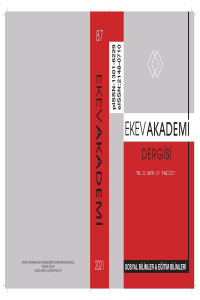A CRITICAL EXAMINATION OF (NON-) ESSENTIALIST CULTURAL DISCOURSES EMBEDDED IN THE TEXTBOOK SERIES “ENGLISH FILE”
Öz
In today’s various language learning contexts in which the reflection of English
language uses for intercultural communication becomes prominent, the core resources
of the language classrooms, be they virtual or face-to-face, are still textbooks. Therefore,
the stance taken while constructing the multimodal components in the textbooks would
influence whether language learners will develop an understanding of the target language
community in line with an international perspective or not. In this vein, our study is a
critical examination of (non)-essentialist cultural discourses in cultural representations
in the visuals and the texts of English File Fourth Edition Elementary, Pre-Intermediate
and Intermediate Student’s Books. Taking account of multimodality in both semiotic and
social-historical rhetorical senses and acknowledging the pedagogic-didactic nature of
the textbooks, we focused on different meaning-making tools like images and texts and
the interaction between them within the scope of this article. Findings showed that the
textbooks mostly perpetuate an essentialist perspective of culture, favouring “Western”,
especially British, and American cultural representations, besides some texts addressing
neo-essentialist perspectives. The elementary book has the highest number of essentialist
texts in which “the West” is described and emphasised constantly, while the pre-
intermediate book, albeit with a few texts from a critical perspective, is mostly composed
of neo-essentialist elements. Lastly, the intermediate book can be viewed as the most non-
essentialist one among others, since it consists of the highest proportion of interpersonal
and intercultural exchanges without a specific reference to a cultural arena that is both
predefined and defining in the series, though half of the texts still make a reference to the
“Western” countries in the intermediate book as well.
Anahtar Kelimeler
EFL Textbook Analysis Cultural Discourses (Non) Essentialism Neo- Essentialism Intercultural Communication.
Kaynakça
- Aliakbari, M., & Faraji, E. (2011). Basic principles of critical pedagogy. The 2nd International Conference on Humanities, Historical and Social Sciences (pp. 77–85). Singapore: IACSIT Press.
- Arikan, A. (2005). Age, gender and social class in ELT coursebooks: A critical study. Hacettepe Üniversitesi Eğitim Fakültesi Dergisi, 28(28), 29-38.
- Cunningworths, A. (1979). Choosing your coursebook. Oxford: Heinemann.
- Çakır, İ. (2010). The frequency of culture-specific elements in the ELT coursebooks at elementary schools in Turkey. Novitas-ROYAL (Research on youth and language), 4(2), 182-189.
- Çelik, S., & Erbay, Ş. (2013). Cultural perspectives of Turkish ELT coursebooks: Do standardized teaching texts incorporate intercultural features? Education & Science/Eğitim ve Bilim, 38(167), 336-351.
- García, M. D. C. M. (2005). International and intercultural issues in English teaching textbooks: The case of Spain. Intercultural Education, 16(1), 57-68.
- Gholami Pasand, P., & Ghasemi, A. A. (2018). An intercultural analysis of English language textbooks in Iran: The case of English Prospect Series. Apples: Journal of Applied Language Studies, 12(1), 55–70.
- Holliday, A., Hyde, M., & Kullman, J. (2004). Intercultural communication: An advanced resource book. London: Routledge.
- Holliday, A. (2010). Cultural descriptions as political cultural acts: An exploration. Language and Intercultural Communication, 10(3), 259–272.
- Latham-Koenig, C., Oxenden, C., Lambert, J., Seligson, P., & Oxford University Press. (2019). English file e-book: Elementary, pre-intermediate and intermediate student’s book (Fourth edition). Oxford: Oxford University Press.
- Liddicoat, A., & Scarino, A. (2013). Intercultural language teaching and learning. Chichester, West Sussex, UK: Wiley-Blackwell.
- Littlejohn, A. (1998). The analysis of language teaching materials: Inside the Trojan Horse. In B. Tomlinson (Eds.), Materials Development in Language Teaching (pp. 190-216). Cambridge: Cambridge University Press.
- McGrath, I. (2002). Materials evaluation and design for language teaching. Edinburgh: Edinburgh University Press.
- Ooiwa-Yoshizawa, A. (2018). Implications of EFL critical pedagogy: Theory, practice and possibility. Learning, 19, 245-253.
- Rashidi, N., Meihami, H., & Gritter, K. (2016). Hidden curriculum:An analysis of cultural content of the ELT textbooks in inner, outer, and expanding circle countries. Cogent Education, 3(1), 1-17.
- Risager, K. (1991). Cultural references in foreign language textbooks: An evaluation of recent tendencies. In D. Butties & M. Byram (Eds.), Mediating languages and cultures: Towards an intercultural theory of foreign language education (pp. 181-192). Clevedon, UK: Multilingual Matters.
- Risager, K. (2021). Language textbooks: Windows to the world. Language, Culture and Curriculum, 34(2), 119-132.
- Riasati, M.J.,& Mollaei, F.(2012).Critical pedagogy and language learning.International Journal of Humanities and Social Science, 2(21), 223–229.
- Song, H. (2013). Deconstruction of cultural dominance in Korean EFL textbooks. Intercultural Education, 24(4), 382–390.
- Spencer-Oatey, H., & Franklin, P. (2009). Intercultural interaction: A multidisciplinary approach to intercultural communication. Basingstoke: Palgrave Macmillan.
- Şimşek, M. R. (2017). Confronting culture in local and global English coursebooks: Student teachers’ preferences in materials adaptation. Journal of Theory and Practice in Education, 12(2), 277-300.
- Ulum, Ö. G., & Erdoğan, B. A. D. A. (2016). Cultural elements in EFL course books. Gaziantep University Journal of Social Sciences, 15(1), 15-26.
- Zacharias, N. T. (2005). Teachers’ beliefs about internationally-published materials: A survey of tertiary English teachers in Indonesia. RELC Journal, 36(1), 23–37.
Ayrıntılar
| Birincil Dil | İngilizce |
|---|---|
| Bölüm | Makaleler |
| Yazarlar | |
| Yayımlanma Tarihi | 21 Eylül 2021 |
| Yayımlandığı Sayı | Yıl 2021 Sayı: 87 |

